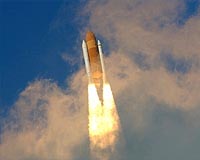 |
Tucson AZ (SPX) Aug 26, 2009 It's time to find out if humans can permanently live and work in space, according to an article written by Mark Sykes and published in the Arizona Daily Star, Tucson, Arizona's morning newspaper. "This has never been a part of U.S. space policy, despite a long history of public relations implying the opposite," Sykes says. Sykes, CEO and director of the Tucson-based Planetary Science Institute, has a poster hanging in his office that shows astronaut Buzz Aldrin on the moon next to an American flag. The caption reads: "Remember your dreams THEN of NOW." When that photo was taken in 1969, Americans believed they would lead the way into space and by 2009 people would be working in well-established colonies on the moon and Mars and even in space habitats, Sykes said. Instead, after hundreds of billions of dollars spent and the loss of many lives in our human space-flight endeavors, NASA has announced plans to abandon and de-orbit its only platform in space - the International Space Station. The orbiting platform will be scuttled in 2016, only five years after its completion. "This is a tragic waste that reveals the ongoing hollowness of U.S. human space-flight policy," Sykes said. But this isn't NASA's fault, Sykes noted. The agency only carries out policy. The fault lies with more than 40 years of failed, short-sighted leadership by both political parties. "The ball is now in President Obama's court," Sykes said. Two problems have to be addressed before we'll know whether humans can live anywhere but Earth: 1) Can we find economical space resources, such as water, to provide fuel and other materials needed to support ever-expanding human activities? Finding and exploiting extraterrestrial resources is vital. Otherwise we will forever be limited by the large expense of transporting everything from Earth's surface. 2) Can humans, plants and animals survive for lifetimes in low-gravity environments? If not, then visions of colonizing the moon and Mars will have to be abandoned. "These are exciting questions," Sykes said. Answering the first will require targeted science and robotic missions. If we can identify and obtain water cost-effectively from the moon, asteroids and dead comets near Earth, we'll have a critical resource we need to take life into space, Sykes explained. But locating and developing potential off-planet resources will not happen by accident. "There must be a carefully planned, systematic effort." Scientific experiments aboard the space station can help answer the second question, Sykes observed. A centrifuge slated for the station was canceled in 2006. It could have been used to conduct the experiments needed to address the effects of low-gravity environments on life, Sykes said. The space station also is the best place to develop resource-extraction processes that will be needed on Near Earth Objects, which have almost no gravity. "We will need a space station for as long as we pursue the possibility and reality of a permanent population beyond Earth," he added. The United States is uniquely positioned to take up this challenge that was fixed in the public mind decades ago, Sykes said. "We have a broad and deep scientific bench and the necessary technical capabilities. The work that needs to be done is known and would represent a small fraction of the annual human space-flight budget." "If we learn that there are no economically recoverable resources or that our biology does not support living beyond the Earth, we can design a focused, cost-effective human space flight program to meet our strategic needs within those constraints," Sykes explained. Unfortunately, this is not a part of any scenario under consideration by the presidential panel, led by Norman Augustine, former chief executive of Lockheed Martin, Sykes noted. The panel has been tasked to consider options for the future of human space flight. "At a fundamental level, it is business as usual," Sykes said. "We need a new focus that finally takes on a decades-old dream - a dream that resonates with an American history built on facing the unknown and opening up new frontiers for future expansion." Share This Article With Planet Earth
Related Links Planetary Science Institute Space Tourism, Space Transport and Space Exploration News
 Launchspace Solar System Exploration Architecture: Reader Responses
Launchspace Solar System Exploration Architecture: Reader ResponsesBethesda MD (SPX) Aug 24, 2009 Wow! Launchspace received a large number of emails regarding last week's commentary by George Jeffs. Most were in agreement with some or all elements of Launchspace's suggested solar system architecture approach. Many said it was a common sense way to structure affordable exploration while maintaining a continuous human space flight capability. There was considerable concern about the ... read more |
|
| The content herein, unless otherwise known to be public domain, are Copyright 1995-2009 - SpaceDaily. AFP and UPI Wire Stories are copyright Agence France-Presse and United Press International. ESA Portal Reports are copyright European Space Agency. All NASA sourced material is public domain. Additional copyrights may apply in whole or part to other bona fide parties. Advertising does not imply endorsement,agreement or approval of any opinions, statements or information provided by SpaceDaily on any Web page published or hosted by SpaceDaily. Privacy Statement |